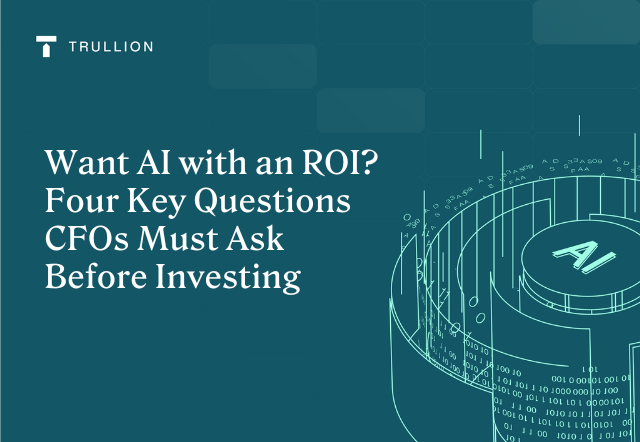While the CFO’s title may have “Finance” in it, the role is significantly more far-reaching. CFOs sit at the intersection of business strategy and operational execution and are increasingly looked to for a lot more than just the pure finance function.
With AI projects being pushed by various departments as well as Boards and even investors, it’s up to the CFO to assess these projects and make decisions regarding what’s best for the company from both a strategic and operational perspective.
We’ve gathered the key questions CFOs should ask when it comes to new AI projects presented to the organization.
Key questions to ask about new AI projects
The array of questions can be categorized under the following primary themes:
- Does this align with our strategic objectives?
As financial custodians of the business, CFOs have both the long-term and immediate moves of the company in mind.They are therefore uniquely positioned to assess any new AI initiatives in the context of the strategic direction of the company, and to ensure that these projects align with overarching company plans.
It’s eye-opening to note that projects aligned to strategy are 57% more likely to deliver their business benefit.What’s more, they have a 50% greater chance of being completed on time, and a 45% higher probability of coming in within budget.
- What are the potential risks involved and can they be managed?
Few individuals within a company are as adept at recognizing and managing risk as the CFO. When it comes to integrating new AI projects, there’s inherent risk that must be weighed against potential benefits, taking into account the organization’s risk tolerance and the magnitude of associated risks.At times, a CFO or the company might opt against initiating a specific AI project due to its risks, or decide to discontinue ongoing projects if the risks are deemed excessively high.
An example of this is IBM Watson for Oncology. This AI-powered technology – intended to revolutionize cancer treatment by using AI to analyze vast medical databases for personalized care – encountered significant hurdles, and was eventually suspended due to the potential risks involved.
Despite its advanced capabilities, it often provided recommendations that conflicted with experts’ opinions, it experienced challenges in keeping its knowledge base current, and could sometimes err in interpreting complex patient data.
The experience underscored the gap between AI’s theoretical promise and its clinical application, leading IBM to reevaluate its approach.
In general, AI risks can be managed by ensuring data quality and strong governance, building in guardrails and other safeguards, starting with closed domain projects, first testing AI projects in non-production environments, and using proven purpose-built AI-powered software that can be easily added to your tech stack.
- What is the expected ROI and timeline?
Like any project, a new AI initiative must be evaluated qualitatively and quantitatively to assess its viability and desirability.Capital budgeting techniques such as Net Present Value (NPV), Internal Rate of Return (IRR), and calculating the Payback Period can help CFOs assess whether a project is expected to generate value for the company, and if it’s worth the investment of resources.
For example, if calculating the NPV for a proposed AI project, CFOs will gather the following data points:
– Initial Investment: The upfront cost required to start the AI project.
– Series of Cash Flows: The expected annual (or periodic) net cash inflows or outflows from the project. These could be increased revenues, cost savings, ongoing operational costs, maintenance, or any other cash expenses or incomes associated with the project.
– Time Periods: Specific time intervals at which the cash flows will occur, often annually for NPV calculations. Knowing the timing is crucial for accurately discounting cash flows back to their present values.
– Discount Rate: The rate used to discount future cash flows back to their present values. This could be the cost of capital, hurdle rate, or any rate that reflects the risk and opportunity cost of the investment.
If the NPV is positive (or the IRR is higher than the cost of capital and/or the payback period is shorter tan a predefined threshold) then, all other things being equal, the AI project should go ahead. - What resources will be required? A CFO must plan ahead in terms of the resources needed for the project to succeed, as well as the opportunity costs involved. Resources might include:
- Technical expertise: Hiring or collaborating with AI specialists and data scientists.
- Technology infrastructure: Investing in the necessary hardware and software for AI development and implementation.
- Data management: Ensuring access to quality data for AI training and operations.
- Training and development: Allocating resources for employee training on new AI systems.
- Legal and ethical compliance: Addressing privacy, data protection, and ethical concerns related to AI usage.
- Financial investment: Budgeting for upfront costs and ongoing maintenance.
Asking the right questions about AI projects
By asking these questions, and assessing the potential project’s strategic fit with the company’s long-term goals, the risks involved and how these can be managed, ROI and timeline, and the specific resources required, CFOs are in a powerful position to commit to the right AI projects.
A great example of an AI project that checks all these boxes is Trullion’s AI-powered automated accounting software.
- It frees up CFOs and other key team members to focus on strategic initiatives, while enabling increased accuracy and transparency for all stakeholders.
- There are minimal risks involved – the software is robust with an extensive track record.
- The solution can be set up quickly and seamlessly, returning near immediate ROI in terms of hours saved.
- Being SaaS-based means that hardly any additional resources are required.
To learn more about how Trullion can help you become a more strategic voice in your organization, reach out to the Trullion team today.









